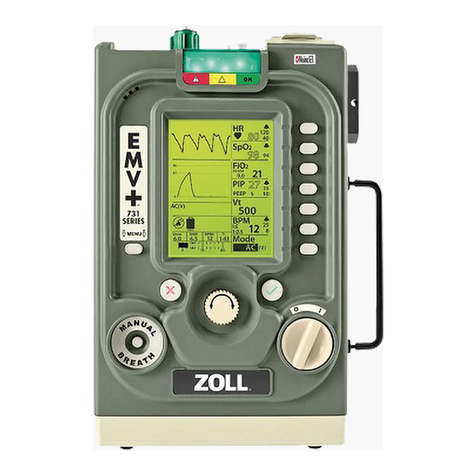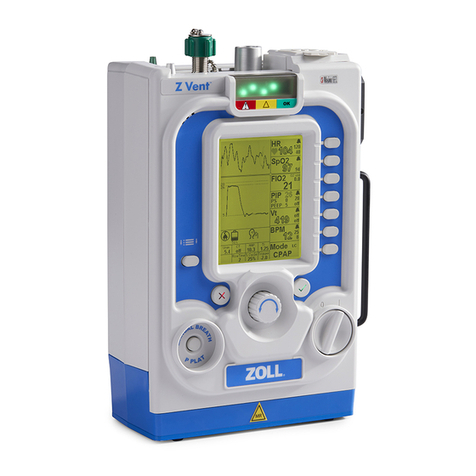
TABLE OF CONTENTS
ii www.zoll.com 906-0731-01 Rev. J
Set-up................................................................................................................................2-23
External Gas Sources ...............................................................................................2-24
Ventilator Circuits: Connections ................................................................................2-26
Ventilator Circuits: Patient Connections ....................................................................2-27
Ventilator Circuits: Resistance, Compliance, and Deadspace ..................................2-28
Operating Power Selection and Stopping .................................................................2-29
Power Supply Connections .......................................................................................2-30
Self-Check ................................................................................................................2-31
Transducer Calibration (AUTO CAL) ........................................................................2-31
Pulse Oximeter Principles.................................................................................................2-32
Chapter 3 Operation
Overview .............................................................................................................................3-1
Introduction .................................................................................................................3-1
Pulse Oximeter ...........................................................................................................3-2
Operation ............................................................................................................................3-3
Modes of Operation ....................................................................................................3-3
Additional Adjuncts of Operation .................................................................................3-4
Spontaneous/Assisted Breath Trigger ........................................................................3-6
To Begin Ventilating ....................................................................................................3-7
To Change Settings ....................................................................................................3-8
Back Up Ventilator ......................................................................................................3-9
Pulse Oximeter ...........................................................................................................3-9
Humidification .............................................................................................................3-9
Hazardous Environment Filters......................................................................................... 3-11
Bacterial/Viral Filter Use ...........................................................................................3-11
Chemical/Biological Filter Use ..................................................................................3-12
Check Valve on Breathing Circuit when in Hazardous Environments ......................3-12
Harsh Environment Operation...........................................................................................3-13
Airborne Particulates .................................................................................................3-13
Extreme Temperature Environments ........................................................................3-13
Altitude ......................................................................................................................3-14
Rain and Snow ..........................................................................................................3-14
Use of Low Flow Oxygen ..................................................................................................3-15
Use In an MRI Environment..............................................................................................3-18
Chapter 4 Alarms
Smart Help Messages.........................................................................................................4-2
Alarm Priorities ............................................................................................................4-3
Ventilator Alarm Categories ................................................................................................4-4
731 Series Ventilator Alarms...............................................................................................4-9
Patient Alarms .............................................................................................................4-9
Device Alarms ........................................................................................................... 4-11
Environmental Alarms ...............................................................................................4-22






























